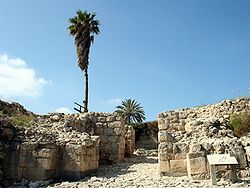Tel Megiddo
Megiddo (Hebrew: מגידו) is a hill in Israel. It is near the modern settlement of Megiddo, and is known for theological, historical and geographical reasons.
| מגידו | |
| Location | Near Kibbutz Megiddo, Israel |
|---|---|
| Region | Levant |
| Coordinates | 32°35′4.64″N 35°11′0.58″E / 32.5846222°N 35.1834944°ECoordinates: 32°35′4.64″N 35°11′0.58″E / 32.5846222°N 35.1834944°E |
| Type | Settlement |
| History | |
| Founded | c. 7000 BCE |
| Abandoned | 586 BCE |
| Official name | Biblical Tells – Megiddo, Hazor, Beer Sheba |
| Type | Cultural |
| Criteria | ii, iii, iv, vi |
| Designated | 2005 (29th session) |
| Reference no. | 1108 |
| State Party | Israel |
| Region | Asia-Pacific |
In ancient times, Megiddo was an important city-state. It is also known alternatively as Tel Megiddo (Hebrew) and Tell al-Mutesellim (Arabic). According to some interpretations of the Christian Bible, this will be the place for Armageddon (that derives from the name's place in Hebrew) or the final battle between the forces of light led by Jesus Christ and the forces of darkness led by Satan or the Anti-Christ after the "End of Days".[1]
Megiddo is a tel (hill or mound) made of 26 layers of the ruins of ancient cities in a strategic location at the head of a pass through the Carmel Ridge, which overlooks the Valley of Jezreel from the west.
Tel Megiddo Media
Gate 2156, built by a proto-Israelite power or during the Omride dynasty (Late Iron Age IIA, c. 900–780 BCE).
The Assyrian period, when the site was called Magiddu, c. 732–609 BCE – plan and ruins
A view of Jezreel Valley and Mount Tabor from Megiddo
A circular altar-like shrine from the Early Bronze Age
A female sphynx plaque, ivory, Megiddo 1300-1200 BC
References
- ↑ "Megiddo". BibArch. February 13, 2009. Archived from the original on May 11, 2008. Retrieved February 17, 2008.
![]()






